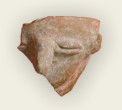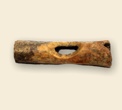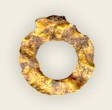|
|
| Small finds |
 It is possible to divide the finds into two categories: those that are collected and stored in groups according to their excavation unit, and those that are collected and stored separately with an individual catalogue number. In the first category falls a large part of the pottery, along with the organic remains (bone and shell). The second category includes all the remaining artefacts, which are defined as moveable; that is all the remaining artefacts from the material that does not form part of a stable construction in the space. It is possible to divide the finds into two categories: those that are collected and stored in groups according to their excavation unit, and those that are collected and stored separately with an individual catalogue number. In the first category falls a large part of the pottery, along with the organic remains (bone and shell). The second category includes all the remaining artefacts, which are defined as moveable; that is all the remaining artefacts from the material that does not form part of a stable construction in the space. |
| |
| Collection |
 Each such moveable find is collected separately and is accompanied by a label bearing its excavation details (excavation unit, layer, and co-ordinates). This practice helps us to determine, at any given moment, the precise find-spot of the artefact, and its archaeological context. In addition to these excavation details, a preliminary description of the artefact is also written on the label. The main descriptive categories used concern the material of the object (stone, clay, bone, shell, and metal), and its form, which allows us to determine its use on a preliminary, general level. Each such moveable find is collected separately and is accompanied by a label bearing its excavation details (excavation unit, layer, and co-ordinates). This practice helps us to determine, at any given moment, the precise find-spot of the artefact, and its archaeological context. In addition to these excavation details, a preliminary description of the artefact is also written on the label. The main descriptive categories used concern the material of the object (stone, clay, bone, shell, and metal), and its form, which allows us to determine its use on a preliminary, general level. |
| |
| Tools |
| Most categories of artefacts collected in this way relate to tools of some kind. Stone tools are divided into two types: chipped stone tools, which are thought to have been used for cutting, scraping, and skinning, and ground/polished tools, which are thought to have been used for felling trees, chopping, grinding, and pounding. There is evidence to show that many tools were made up of a group of artefacts. It can be inferred, for example, that sickles were made up of many blades or flakes set into a shaft made of bone or wood. Bone tools, on the other hand, were probably intended for lighter work, such as piercing holes in leather, or sewing. |
|
|
| |
| Weights |
| Another category of tools, or rather of implements, is formed by the various weights, made either of stone or clay. These were probably associated with activities such as weaving (as parts of looms) and fishing (as parts of nets). Where weaving is concerned, one could also associate spindle whorls and pierced discs and shells, which were perhaps used as small weights for the spindle. |
|
|
| |
| Jewellery - Statuettes |
| A third category of artefacts, which are neither tools nor implements, is defined by the objects we call jewellery although it is unclear whether this term correctly expresses their use. This same uncertainty characterises our knowledge concerning the use of both stone and clay figurines. Nevertheless, both these categories can provide information useful for the investigation of other matters, such as the way in which the body was construed at that time. |
|
|
| |
| Metal objects |
 Metal artefacts are not very common in a Neolithic excavation and are mainly to be found in the later levels. However even these are useful, since they indicate possible disturbances in the Neolithic levels. Metal artefacts are not very common in a Neolithic excavation and are mainly to be found in the later levels. However even these are useful, since they indicate possible disturbances in the Neolithic levels.
|
|
|





